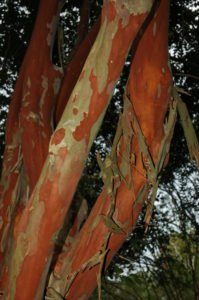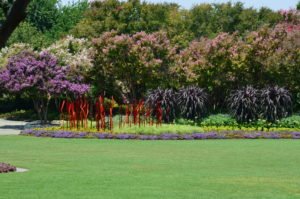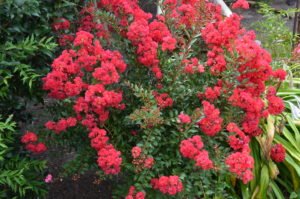What to Plant Around 5 Feet Crepe Myrtle
 The way crape myrtles look in February and March is a travesty (a distorted representation of a tree) and a tragedy (an outcome causing great suffering devastation and distress) to the individual plants. To what am I referring, but the way the trees go brutally whacked and chopped by loppers and saws, and then get loaded into a big trailer adding to the landfill!! If they are too tall, pull them out and plant shorter varieties, but Crape Myrtles rarely or never demand pruning.
The way crape myrtles look in February and March is a travesty (a distorted representation of a tree) and a tragedy (an outcome causing great suffering devastation and distress) to the individual plants. To what am I referring, but the way the trees go brutally whacked and chopped by loppers and saws, and then get loaded into a big trailer adding to the landfill!! If they are too tall, pull them out and plant shorter varieties, but Crape Myrtles rarely or never demand pruning.
Crape Myrtles are TREES and that means they grow TALL from twenty – 40' in height. They have been lovingly referred to as the Lilac of the South (with no fragrance) with a very long blossom fourth dimension in the summer. Crape myrtles take wonderful exfoliating bark in late spring/early summer that as a kid, I loved to peel off the body to reveal a cute, velvety, cinnamon colored trunk. The leaves likewise provide great fall colour from yellowish to orange to red if the weather cooperates. Then hither nosotros have a constitute that give us an exceptionally long summer bloom menstruation, dandy fall foliage (non many trees practise that hither) and a beautiful sculptured trunk when immune to grow naturally.
 There are 2 types of Crape Myrtle frequently planted; in that location is Lagerstroemia indica and Lagerstroemia hybrid (indica x fauriei). The first species L. indica has modest round leaves and is terribly susceptible to powdery mildew which is a white powder that causes the leaves to curl up and misconstrue, stops photosynthesis and occurs in leap AND fall. Powdery mildew must exist sprayed with several fungicide applications OR you can plant the National Arboretum Hybrids which are totally resistant to powdery mildew.
There are 2 types of Crape Myrtle frequently planted; in that location is Lagerstroemia indica and Lagerstroemia hybrid (indica x fauriei). The first species L. indica has modest round leaves and is terribly susceptible to powdery mildew which is a white powder that causes the leaves to curl up and misconstrue, stops photosynthesis and occurs in leap AND fall. Powdery mildew must exist sprayed with several fungicide applications OR you can plant the National Arboretum Hybrids which are totally resistant to powdery mildew.
The Hybrid Crape Myrtle, Lagerstroemia indica x fauriei, (Indian Tribe Hybrids and named so) was started by Dr. Donald Egolf of the National Arboretum beginning in 1959. He started a research project to develop disease resistance (powdery mildew), hardiness (because fauriei species was more than frost tender that indica) rebloomers, true bloom color and  unique inheritable dark torso colors. The hybrid crape is hands distinguished from the species as it has larger rectangle leaves, larger flowers and bloom clusters and is totally resistant to powdery mildew – never spray fungicide again!
unique inheritable dark torso colors. The hybrid crape is hands distinguished from the species as it has larger rectangle leaves, larger flowers and bloom clusters and is totally resistant to powdery mildew – never spray fungicide again!
Some of the National Arboretum hybrids you may be familiar with are:
Muskogee – to xxx' – light lavender bloom – crimson orange fall color
Tuscarora – to 20' – nighttime coral pink bloom – ruby-red orange fall color
Natchez – to thirty' – white blossom – cinnamon colored trunk – yellow to red to orange autumn colour
Arapaho – 20-30' – true red bloom – maroon tinged leaves
Fantasy – 25-forty' – white bloom, fragrance emits a sweetness nectar for bees, cinnamon torso
If you do not have the space for a 20 or 30 foot tree endeavor using i of the shrub or dwarf varieties.
Chickasaw – 1-3' shrub – light lavender pink
Chica – 2-4' shrub – deep crimson
Pokomoke – three-5' shrub – deep rose pink
Hopi – 5-10' large shrub – clear light pink
Dynamite – vi-eight' dense shrub – true crimson
Acoma – 6-10' – white flowers – semi- dwarf weeping addiction
Catawba – 8-10' – violet purple – dumbo shrub
CRAPE MYRTLE TIPS:
 1) Do not plant in the bloom beds next to the business firm; INSTEAD use a tall diverseness in the centre of the chiliad to provide summertime shade on the due west side of the firm.
1) Do not plant in the bloom beds next to the business firm; INSTEAD use a tall diverseness in the centre of the chiliad to provide summertime shade on the due west side of the firm.
2) Crape Myrtles are either single body or multi-trunked and it can take a long time to turn a multi trunk into a single trunk, so purchase single trunk to begin with if that is what y'all demand.
3) Plant the hybrids with the large leaves to avoid powdery mildew in the jump and fall.
4) Crape Myrtles need at least 6 hours of DIRECT Sun for good, long summer bloom.
5) Lookout man for Crape Myrtle Asian Bawl Scale, it turns the trunks completely black and must be treated systemically and topically. Severe pruning seems to attract these sucking insects.
 6) Pruning should simply be done when copse are young to shape the tree past removing crossing and rubbing branches and dead wood. You could remove seed heads in the winter but this is how all the abuse started, because it was likewise time consuming to snip the tips and progressed into the crape murder nosotros accept come to recognize today. (If you take copse that have been chopped down to shoulder or waist height, remove it for it will never exist beautiful again.)
6) Pruning should simply be done when copse are young to shape the tree past removing crossing and rubbing branches and dead wood. You could remove seed heads in the winter but this is how all the abuse started, because it was likewise time consuming to snip the tips and progressed into the crape murder nosotros accept come to recognize today. (If you take copse that have been chopped down to shoulder or waist height, remove it for it will never exist beautiful again.)
Finally, yous be the teacher and assistance educate those holding the chain saws and pruners to finish the horrible disfiguring of our beautiful sculptured trees and know, no pruning is necessary if the trees have never been pruned.
Take a great jump!!
wadealianobson1957.blogspot.com
Source: https://arborgate.com/blog/garden/please-stop-planting-crape-myrtles/